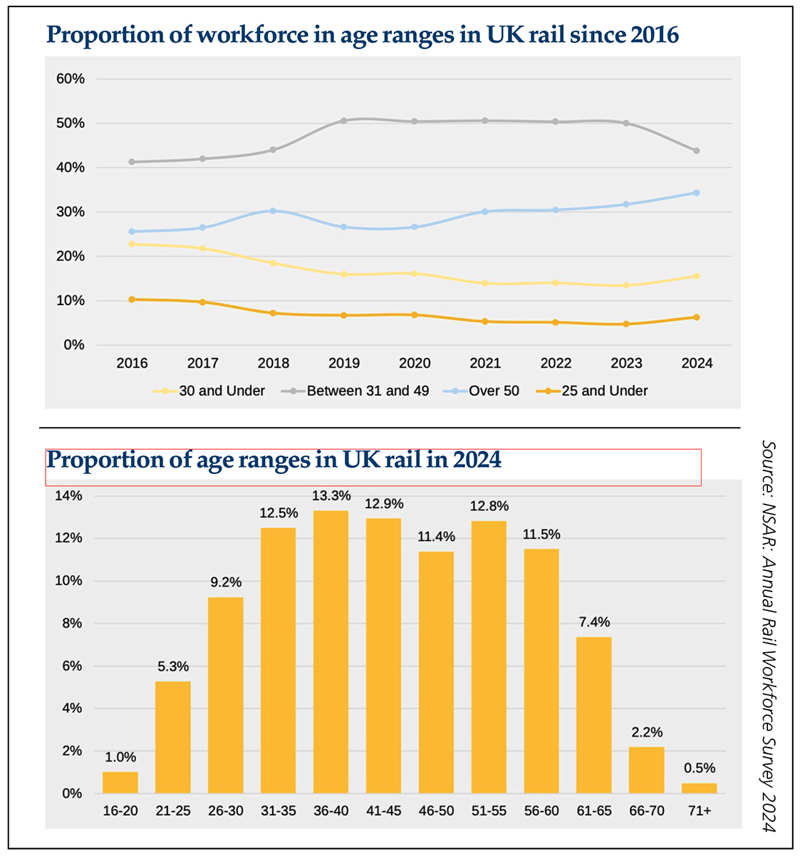You just can’t get the staff, can you?
The rail industry, like many other sectors of the economy, is facing a looming skills shortage and related recruitment challenges.
You just can’t get the staff, can you?
The rail industry, like many other sectors of the economy, is facing a looming skills shortage and related recruitment challenges.
There are multiple root causes, but one of the key contributing factors is losses to retirement.
We’ve known for some time that there’s a retirement wave on the horizon - but in this issue, we reveal just how huge it is and when it will be felt (see pages 30-33).
The average age for retirement in rail is much lower than the national average. And in the supply chain, 30% of employees are expected to retire in the next five years.
This trend towards taking early retirement is particularly strong among long-career rail workers with specialist rail skills, as they are the employees most likely to be in a position to enjoy final salary pension schemes.
Those with transferable skills, who are more likely to have moved around before entering the sector, tend not to have such attractive pension packages. However, the very fact that their skills are so transferable is a problem in itself, because they can easily be lost to other industries.
But the looming recruitment crisis is down to more factors than just staff retiring. It’s also about replacement. Where is the new talent to come from at the other end of the age scale, to offset the number of those retiring?
This is a common problem worrying many industries. And all too often, the skills being sought across economic sectors are quite similar.
Diverse industries are looking for new recruits who possess the same digital skills for their own digital transformations. And rail is no exception. So, rail will be competing with energy, civil engineering, construction, other transport sectors… and many more.
All these sectors will be scrabbling to attract future talent, and even competing with the technology sector itself. And that competition will often be international.
So, how does rail seek and attract the talent it needs for the long term?
There are several characteristics of the new generation coming into the workforce that could play to rail’s strengths or opportunities.
Generation Z, for example, are more concerned than previous generations about the societal and environmental impact of what they do with their lives - and they have more choice than previously. They care about how their chosen career will affect the planet.
Rail has a genuine strength to exploit here, as one of the lowest-carbon forms of transport - better than cars, air travel, or road haulage. But it doesn’t shout about it as much as it could. It might market that advantage more strongly.
Similarly, young people also care about their employers’ diversity, equality and inclusion efforts.
Some corporates are dropping or quietly forgetting those goals, in the wake of US political trends. But rail should stick with them if it is to appeal to a new generation of candidates.
Diversity policies widen recruitment pools by themselves, of course. But environmental and social goals together can also make employers more attractive to a new generation that can choose their employer - and are more likely to do so based on factors beyond T&Cs.
At a time when rail will be competing with other careers and industries, it needs to make the most of what strengths it has.
While existing workers might be wary of new technology, the younger ones are more likely to seek it out in a future career and employer.
They will look for employers that embrace new ways of doing things with new tech. And they would hope that those employers will support them to develop those skills, which in turn will provide them with employment security for the future.
As Paul Clifton was told, in researching our cover feature, skills shortages could help to push the rail industry further towards embracing technology, investing in automation, and other ways to work around an increasingly tough recruitment market. Investing in that way will also help them to attract the staff they seek.
Whatever recruitment problems it faces, all the forecasts look good for rail transport. Passenger numbers are growing and are set to multiply over the next few decades.
The rail industry has a bright future. But it needs the people to deliver it.

Login to continue reading
Or register with RAIL to keep up-to-date with the latest news, insight and opinion.



















Login to comment
Comments
No comments have been made yet.